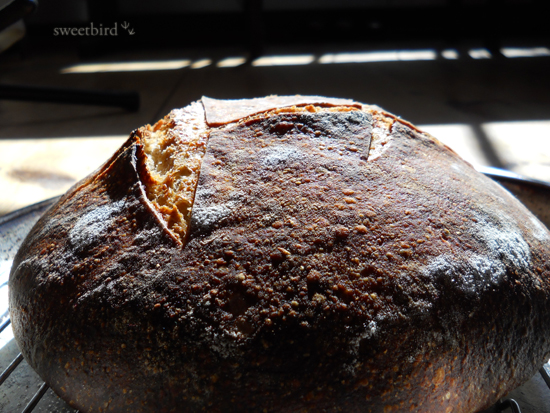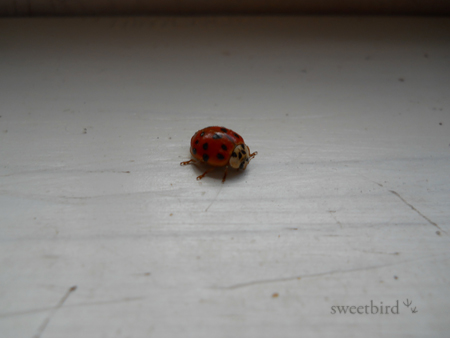
I can’t seem to resist any opportunity to watch a sourdough culture get its start. I’ve made many starters over the years but it never loses its fascination for me. I love watching the miracle of wild yeast emerge. That’s what drew me to this formula in Joe Ortiz’s book The Village Baker. It had the added charm of being an authentic formula that has been passed down through the ages. According to the author, it has been in use for hundreds of years by home bakers who gathered once a week in the French countryside to bake in communal ovens. I was drawn to it like a moth to a flame.
It takes about 6 days to complete this, but that’s because you’re building a sourdough culture from scratch. You could substitute an already thriving sourdough culture of your own, but you’d miss out on all the fun (and probably end up with a good but different-tasting loaf). This deeply wheaty and tangy levain lets you know, without any doubt, that it is there in the final loaf.
As I did with my previous Joe Ortiz formula, I’ve done metric conversions while still providing his original measurements for anyone who prefers those. I didn’t convert the tiny amounts to metrics. Also, as in my previous Joe Ortiz loaf (the Pumpkin Seed sourdough), I’ve increased the quantity of salt from 2½ tsp. to a rounded Tbs. and have used Celtic salt.
He isn’t very specific about temperatures, instead using terms like “warm” or “very warm.” I used my judgment and generally took “warm” to be in the mid- to upper-80sF and “very warm” to be anywhere from the 90sF up to 100F. Of course, it also depends on the weather, etc., so it’s best left up to the baker.
This makes one large 2-lb. or approximately 1034 gm loaf.
Chef (2-3 days):
78 gms organic whole wheat flour (½ C.)
46 gms warm water (scant ¼ C.)
1/8 tsp. cumin
½ tsp. whole organic milk
First refreshment (18-24 hrs.):
117 gms organic whole wheat flour (3/4 C.)
72 gms warm water (1/3 C.)
44 gms chef (2 Tbs.)
Second refreshment (10-12 hrs.):
115 gms levain from the first refreshment (½ C.)
117 gms organic whole wheat flour (3/4 C.)
70 gms organic unbleached AP flour (½ C.)
115 gms warm water (½ C.)
Dough:
420 gms organic unbleached AP flour (3 C.)
342 gms levain from the previous step (1½ C.)
285 gms very warm water (1¼ C.)
15 - 16 gms finely ground Celtic salt (approx. 1 slightly rounded Tbs.)
For this loaf I used organic Central Milling whole wheat flour and King Arthur unbleached AP four. And spring water, which I always use rather than tap because it gives me better and more consistent results.
To make the chef:
His method (presumably the method used for hundreds of years) is to make a mound of flour on your work table and make a well in the center. Into the well pour about two-thirds of the water, and then add the cumin and the milk. With one finger, start mixing and pulling the flour in from the outer ring. Adjust as necessary until you have a firm but somewhat sticky dough. Knead 5 - 8 minutes.
I did it a little differently: I mixed the flour and cumin in a large, wide bowl, made a well, added the liquids and incorporated the flour from the outer ring slowly with a small spatula. I kneaded it right in the bowl; more of a stretch-and-fold technique than a traditional knead.


Transfer to a ceramic or glass container. (Don’t coat with oil.) Cover and let sit in a warm place free from drafts for 2 to 3 days.


A crust will form on the top, but when you peel that back you’ll find a spongy, inflated chef. He describes the aroma as “slightly sour but fragrant and appealing,” which is exactly what I found.
I did my first refreshment after 2½ days, and that happened to be at 8 o’clock in the morning, which turned out to be perfect timing for the rest of the steps, leaving me with a baking schedule that would suit most of us I suppose, which is to bake during daylight hours. I can’t say I planned it that way but once in a while we non-planners get lucky.
First refreshment:
Remove the crust and take 2 Tbs. (about 44 gms) of the sponge. Make a well of the flour, put the chef into the well and add the warm water. After the chef dissolves, begin to draw in the flour from the sides of the well. You should end up with a very firm but still slightly moist ball of dough. You may not even be able to incorporate all the flour. Try to do so, but don’t worry if you can’t.
Transfer to a ceramic or glass container, cover, and let stand for between 18 and 24 hours. I left mine for the full 24 hours. When ready it will have risen noticeably and fallen a little. It will have a “pleasing, alcoholic aroma.” Mine did.
Second refreshment:
Discard any crust but use most of this levain (should be about 115 gms). Hold back some of the flour until you’re sure that you need it. It should be slightly moist to the touch but firm, as the first refreshment was. Let this rise, covered, for between 10 and 12 hours. Mine became active very quickly and rose like a champ throughout the day. It was raring to go by 10 hours, so I went on to the next step, mixing the final dough, which I did in the evening in preparation for a bake the following day.
Beginning of 2nd refreshment:

After 4 hours:

After 8 hours:

Dough:
Make a well in the flour, add all the levain (broken up into pieces) and all the water and mix as before, stopping when you still have about a cup of flour left to incorporate. Add the salt and then incorporate the rest of the flour. Knead for 5 minutes until firm and elastic.
Let rise, covered, for 8 to 10 hours. It should double. I left mine overnight in a cool room (probably about 66°F, give or take a few degrees throughout the winter’s night) and it had doubled beautifully by morning. It was domed, so it hadn’t begun to fall, and it smelled nicely of fermentation.
Deflate gently on your work surface and save a walnut-sized piece of dough for your next bake. About 44 gms or 2 Tbs. is a good amount. You can refrigerate this for a day or two or begin another loaf right away if you like. To make another loaf you would let it sit at room temperature for 4 to 8 hours and treat it as the “chef,” using it in the first refreshment, then continuing on with this formula.
Pre-shape the dough and let rest for half an hour.
Cool trick: when you’re ready to shape, remove another small walnut-sized piece of dough and put it in a Mason jar (or any medium-sized glass jar) filled with room temperature water. Shape your dough and put the dough and the jar with water together in the same warm place. When the little ball of dough pops up and floats in the water, the bread is ready to bake.
Joe Ortiz calls for an 8 to 10 hour rise, but I found mine was ready to go at 3 hours, so you need to be checking your dough as you always do (even if you’re using the Mason jar trick). The important thing is to have your oven and baking stone ready when your dough is ready, so some educated anticipation is called for. The author makes the point that the final rise plus the previous step (the dough rise) should total 16 hours, but I found my levain to be too active to push it that far. That seems like it has to be left up to the baker.
By the way, for large loaves like this one, I’ve used an Easter basket lined with cloth for years and it works great. It cost about 99 cents. I searched around for one with the size and shape I wanted; this one is nicely rounded from rim to rim, and once the handle was removed it was perfect.

Preheat the oven and stone to 450°F about 45 minutes before you expect to bake, and prepare for steam. Score and load the loaf and adjust the temperature down to about 400°F or 425°F if your oven tends to bake hot. Mine does, so I went down to 425°F. Remove steam apparatus after 10 - 12 minutes and rotate halfway through for even browning. He recommends baking for a full hour, but mine was ready at about 40-45 minutes or so. I turned the oven off and left the door ajar for 10 minutes.
When I transferred this loaf to the peel, I had a bad feeling that I had over-proofed it. It seemed flabby. That may—or may not—account for my inelegant scoring:

I didn’t think I was going to get any oven spring, but I ended up getting a moderate amount. Not perfect by any stretch, and a bit of a clumsy shape, but not a disaster. The color was deep (somewhere between the film noir shot at the top and the sun-drenched shot just above) and the crust was nicely blistered with signs of fermentation. The real joy came when I tried my first slice. I LOVE this bread! It has a genuine, pronounced sourdough tang and the flavor of well-developed, long-fermented wheat, which is brought about by the leisurely development of the levain, but also by the generous proportion of levain in the final dough.


My husband Angelo especially loved it too. He has a wheat sensitivity (but not an allergy, thank goodness), so he’s not supposed to eat much wheat, but he can’t resist trying some when I bake. I am thrilled with it and will make it again and again. Someday I’ll try it with one of my standard starters and report back on the results. At the moment, I’m in the process of refreshing the “old dough” from this bake in preparation for another loaf in a few days.
This little sweetie seems to like the smell of freshly baked bread, because she has a habit of showing up when I do my "photo shoots." Now I have a good shot of her face so I'll know who the culprit is if some of my bread mysteriously goes missing!

Happy baking to all,
Janie
p.s., submitted to Susan for yeastspotting http://www.wildyeastblog.com/category/yeastspotting/